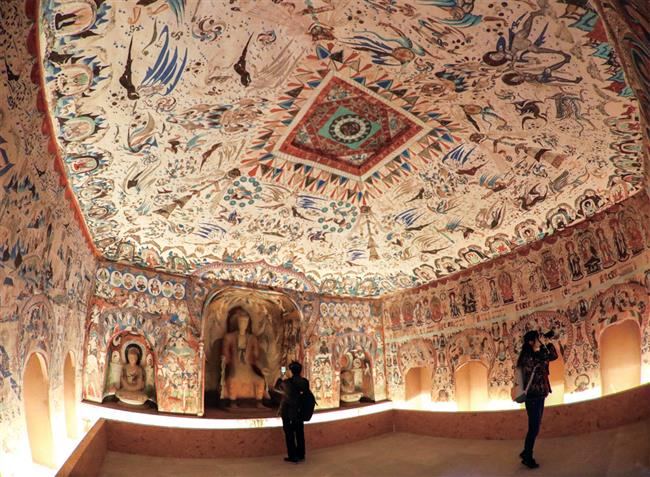
People take photos yesterday inside a replica in Shanghai Tower of the No. 285 grotto at the Mogao Caves. Mogao is said to have the richest content of all the grottoes at Dunhuang in northwest China. Three grottoes at Dunhuang have been replicated in Shanghai’s tallest building for an exhibition that opens to the public next month. The full-size facsimiles — two grottoes from Mogao Caves and one from Yulin Caves — have been installed in Shanghai Tower. Dating from the 5th to early 11th centuries, they show the typical features of three different periods of the Dunhuang grottoes, the world’s largest treasury of Buddhist art, said Mi Qiu, curator of the exhibition. Frescoes in the original caves have been copied using high-definition scanning and printing technologies, Mi said. The exhibition will open on April 28 in the tower’s exhibition hall and will run until February. It will also feature over 118 precious cultural relics from seven museums in Gansu Province, many of them being shown in the city for the first time.
THREE grottoes at Dunhuang in northwest China have been replicated in the city’s tallest building for an exhibition which opens next month.
The full-size facsimiles — two grottoes from Mogao Caves and one from Yulin Caves — have been installed in the 632-meter Shanghai Tower.
Dating from the 5th to early 11th centuries, they show the typical features of three different periods of the Dunhuang grottoes, the world’s largest treasury of Buddhist art, said Mi Qiu, curator of the exhibition.
Frescoes in the original caves have been copied using high-definition scanning and printing technologies, Mi said.
The exhibition will open to the public on April 28 in the tower’s exhibition hall and will run until February next year. It will also feature over 118 precious cultural relics from seven museums in northwest China’s Gansu Province, many of them being shown in the city for the first time, including bronze statue “Horse Stepping on Swallow” from the Eastern Han Dynasty (AD 25-220).
The statue, part of the Gansu Museum collection, was unearthed in 1969 from the tomb of a military officer of Zhangye City. It was selected by the China National Tourism Administration as the country’s official tourism logo in 1983.
The No. 29 grotto at Yulin Caves presents the full ethnic flavor of the Western Xia (1038-1227) regime, Mi said, and represents the artistic achievements of the Dunhuang Caves.
Mogao Caves’ No. 220 grotto features frescoes from the early Tang Dynasty (618-907), depicting many ancient musical instruments and dances.
The No. 285 grotto dates back to the Western Wei Dynasty (535-556) and is said to have the richest content of all grottoes in Dunhuang. It features Buddhist and Taoist figures.
“The fresco creates a prosperous and peaceful atmosphere of paradise,” Mi said. “It was once used for Zen Buddhists to meditate and get inspired from the paintings.”
Other key exhibits include 10 original Dunhuang manuscripts, a cache of important religious and secular documents discovered in the Mogao Caves in the early 20th century. They include works ranging from history and mathematics to folk songs and dance. Over 50 seminars and events on culture, fashion, music and dance, literature and folk arts will be held during the exhibition.
Entry to the exhibition will cost 180 yuan (US$28.6).
